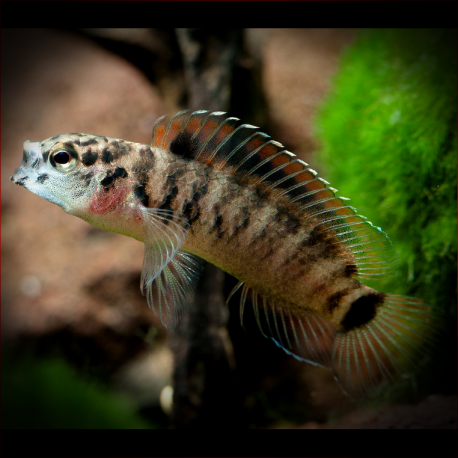More info
Datasheet
| Minimum Tank Size | 60 litres / 15.85 US gallons |
| Maximum Size | 5.0cm / 1.97inches |
| Temperature | 21°C / 69.80°F - 25°C / 77.00°F |
| Hardness | 1.01dgH / 18ppm - 5.04dgH / 90ppm |
| pH | 6.0-7.0 |
General Description:
Badis Juergenschmidti, a member of the family Badidae, is a relatively unknown species in the aquarium hobby. Discovered in the early 2010s, it can be distinguished by specific characteristics such as the absence of certain markings found in other members of the genus.
Aquarium Setup:
For optimal care, a tank of at least 60 liters is recommended, with a well-structured setup comprising a sand or gravel substrate, water-worn rocks, and ample hiding spaces. Live plants like Microsorum and Anubias can be added. Cave-like structures are essential for potential spawning sites, with options like half-coconut shells or clay plant pots being popular choices.
Behaviour:
This species is not gregarious and can display aggression, especially between rival males, necessitating careful tankmate selection. Their slow-moving, deliberate feeding nature makes them vulnerable to intimidation by larger or boisterous tankmates. When a community setup is desired, peaceful species like Trigonostigma or smaller Rasboras are recommended.
Feeding and Diet:
Badis Juergenschmidti are micropredators, feeding on small aquatic crustaceans, worms, insect larvae, and zooplankton. They may not readily accept dried foods, so offering regular small live or frozen foods such as Artemia and Daphnia is crucial for their health and coloration. It is advised to avoid feeding them chironomid larvae or Tubifex to prevent obesity and disease susceptibility.
Reproduction & Dimorphism:
In captivity, these fish are cave spawners, forming temporary pair bonds for breeding. Male and female dimorphism is evident, with males developing extended finnage and more vibrant colors. The breeding process involves courtship behavior, spawning of eggs, and male parental care until the fry become free-swimming.
Habitat and Distribution:
Badis Juergenschmidti is currently only known from the Ka Dat Chaung river system in Mon State, southeast Myanmar. Their habitat typically consists of slow-flowing rivers with shallow water depths, rocky substrates, and minimal aquatic vegetation. They are sympatric with species like Acanthocobitis zonalternans. The region experiences stable air temperatures around 80?F and has distinct wet and dry seasons affecting river conditions.
Distribution:
The distribution of Badis Juergenschmidti is limited to the Ka Dat Chaung river system in Mon State, southeast Myanmar, which is part of the larger Sittaung River drainage system.

